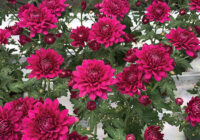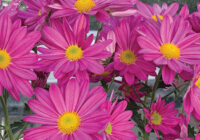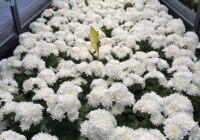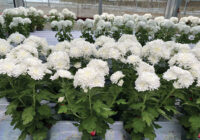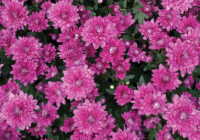
Features
Fertilizer
Flowers
Another look at nutrient delivery for potted mums
Improving micronutrient usage in greenhouse production.
April 26, 2022 By Alyna J. Donetz, Edward J. Flaherty, Katherine Teeter-Wood, Skye Duncan Stephens, Dr. Gordon Hoover, Dr. Chevonne Dayboll, And Dr. Barry J. Shelp
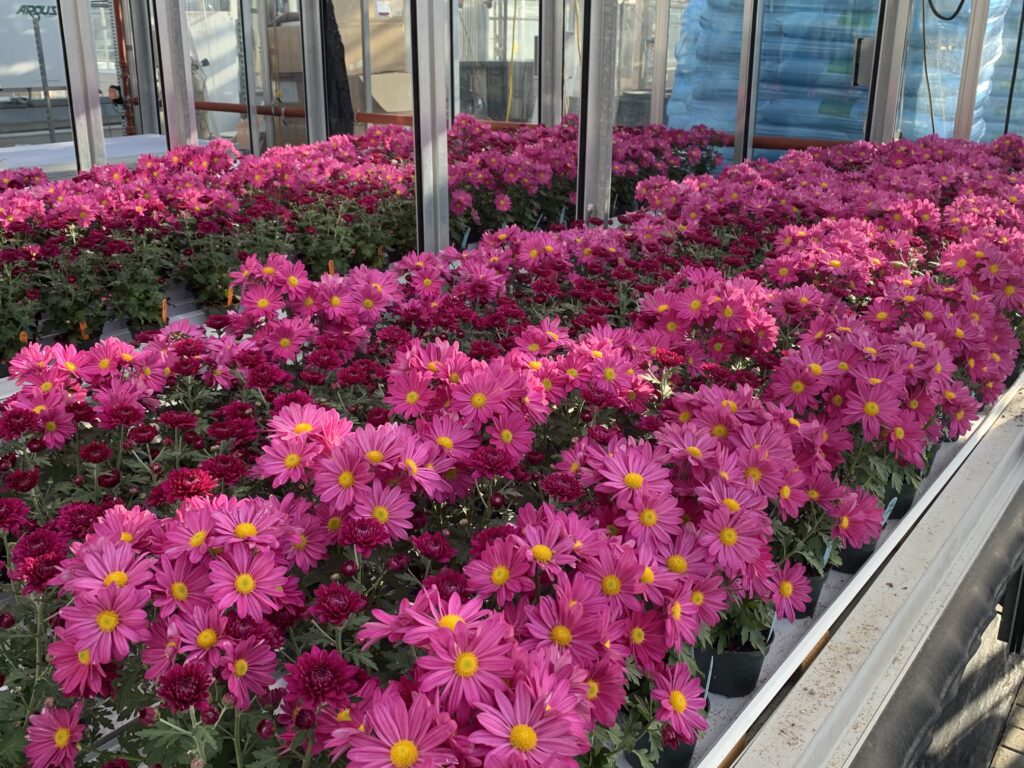 Market-quality ‘Milton Dark Pink’ and 'Williamsburg Purple' chrysanthemums were produced across the different Cu regimens.
Market-quality ‘Milton Dark Pink’ and 'Williamsburg Purple' chrysanthemums were produced across the different Cu regimens. Chrysanthemums are an economically important floricultural crop worldwide. Approximately five million indoor potted chrysanthemums were grown in 2020 in Canada alone, making it the third most produced flower in the country. It was also the fifth most produced outdoor potted plant with three million units, and the third most produced cut flower with 23 million units.
WHY WAS THIS STUDY CONDUCTED?
Indoor potted chrysanthemums are of particular interest because they are widely grown with subirrigation or capillary irrigation. Closed subirrigation systems eliminate the generation of leachate and allow the recycling and reuse of nutrient-rich solution. Historically, there has been an overuse of fertilizer applied to the potted plant.
Previously, our research group used modern cultivars of subirrigated, indoor potted chrysanthemums to demonstrate how the supply of NPK (N, nitrogen, P, phosphorus and K, potassium) could be reduced by approximately 75 per cent during the vegetative stage without compromising quality, and how it could be removed completely when plants were flowering. To continue this work, and to see if further fertilizer savings are possible, we investigated whether the levels of micronutrients (zinc, Zn, manganese, Mn, copper, Cu and iron, Fe) in common pre-mixed fertilizers could be similarly reduced.
WHAT ARE THE KEY FINDINGS?
The Zn and Cu experiments were replicated in a naturally lit greenhouse during the summer/fall of 2019 and winter/spring 2020 seasons. Similar results were found with the cultivars ‘Milton Dark Pink’ and ‘Williamsburg Purple’ (Fig. 1). Results showed that applied levels of Cu and Zn levels could be reduced during the vegetative stage by up to 75 per cent without any visible signs of nutrient deficiency. Furthermore, there was no significant change in quality, as measured by markers such as shoot height and dry weight, leaf greenness, flower number, bloom size and development. The leaf Zn level ranged from 36 to 18 ppm and the leaf Cu level ranged from 7.1 to 3.7 ppm.
The Mn and Fe experiments were conducted in the summer/fall of 2020 and winter/spring 2021 seasons using different treatment rates. Similar results were found with the cultivars ‘Olympia White’, ‘Milton Dark Pink’ and ‘Williamsburg Purple’ (Figs. 2 and 3). This time, results showed that applied levels of Mn and Fe could be reduced by up to 94 per cent during the vegetative stage without any visible signs of nutrient deficiency. Furthermore, there was no significant change in quality. The leaf Mn level ranged from 116 to 51 ppm and the leaf Cu level ranged from 83 to 45 ppm.
HOW CAN THESE FINDINGS BE INTEGRATED INTO YOUR FARM OPERATION?
Many commercial fertilizer formulations (e.g., Peter’s Professional Peat-Lite Neutral Cal-Mag 17−3−17, ICL Fertilizers; Fusion Plant-Prod 17−5−17, Master Plant-Prod), often with similar macronutrient composition (in ppm: 285−300 N; 53−84 P; 285−300 K) are available for chrysanthemum production. These two fertilizers contain (in ppm): 0.75−0.83 Zn; 0.36−0.83 Cu; 0.75−0.83 Mn; 0.1.50−1.68 Fe; 0.34−0.36 boron; and, 0.15−0.26 molybdenum). In the present study, the lowest levels of Zn (0.057 ppm), Cu (0.012 ppm), Mn (0.017 ppm) and Fe (0.037 ppm) delivered during vegetative growth ranged from 2 to 10 per cent of those levels. Nonetheless, the absence of changes in plant and flower quality, as well as visible signs of micronutrient deficiency, suggests that none of the micronutrient regimens employed here limit growth processes. Consequently, the leaf micronutrient levels across all treatments are considered acceptable. This is in line with the desirable micronutrient ranges provided by the Ontario Ministry of Agriculture, Food and Rural Affairs (OMAFRA) in Publication 370, which suggests 5-35 ppm Zn, 5-50 ppm Cu, 25-375 ppm Mn, and 20-750 ppm Fe in leaf dry tissue of the chrysanthemum.
Based upon this research, growers could consider reducing the amount of fertilizer applied to indoor potted chrysanthemum crops grown with subirrigation. Like NPK, the application rate for each of the four micronutrients studied here could be reduced by up to 75 per cent. Initially, the reduced rates could be tested on a small portion of the crop, while tracking plant quality metrics, sell-through and stress tolerance (e.g., shipping tolerance, retail performance if possible) to see if a reduced nutrient strategy might work on a large scale for individual farms.
With our experimental protocol, the amount of fertilizer in the pot medium was minimized by inserting each cutting into a peat Jiffy plug amended with 30 per cent minerals (Model CF Hort. Plug 343040, Jiffy Products (N.B.) Ltd., Shippagan, NB, Canada), and using a peat-based pot mixture (50:50 peat:perlite by volume) without a starter charge. However, Jiffy plugs can be purchased with a greater mineral amendment and many commercially available peat-based mixes do contain proportionately more peat, as well as a starter charge. Also, the Jiffy plug is often omitted, and specific nutrients added directly to the pot mixture. All these supplemental fertilizer sources could allow for further reduction in liquid fertilizers. In this study, we used common indoor potted chrysanthemum cultivars. Cultivars grown as outdoor potted chrysanthemums or as cut flowers with more “showy blooms” may require different nutrient levels to obtain the best market quality. Growers should talk to their suppliers about custom fertilizer options with reduced rates to minimize costs.
Acknowledgements
This project is part of the Accelerating Green Plant Innovation for Environmental and Economic Benefit Cluster and is funded by the Canadian Ornamental Horticulture Alliance (COHA−ACHO) and by the Government of Canada under the Canadian Agricultural Partnership’s AgriScience Program. Industry partners included Schenck Farms and Greenhouses of St. Catharines, Ont., and AgMedica Bioscience Ltd. of Chatham, Ont. Thanks to Berger of Sainte−Modeste, Que., for supplying the peat, and Kuyvenhoven Greenhouses Inc. of Halton Hills, Ont., for supplying the chrysanthemum cuttings.
More information
For more details, see the article, “Optimizing zinc and copper delivery for subirrigated greenhouse-grown chrysanthemums” (http://dx.doi.org/10.1139/cjps-2020-0175), which is published in the Canadian Journal of Plant Science.
For more background, see the articles “Moving towards low-input floricultural operations,” “It’s about time: Using phosphorus efficiently,” and “More for less: Lowering N, P and K in mums,” which are published, respectively, in the December 2018, March 2020 and December 2020 issues of Greenhouse Canada magazine.
Alyna Donetz, Edward Flaherty, Katherine Teeter-Wood, and Skye Duncan Stephens are graduate students, Gordon Hoover is a technician, and Barry Shelp is professor emeritus in the Department of Plant Agriculture at the University of Guelph. Chevonne Dayboll is the greenhouse floriculture specialist at OMAFRA.
For more information, please contact Dr. Shelp at 519-824-4120 ext. 53089, or bshelp@uoguelph.ca.
Print this page
